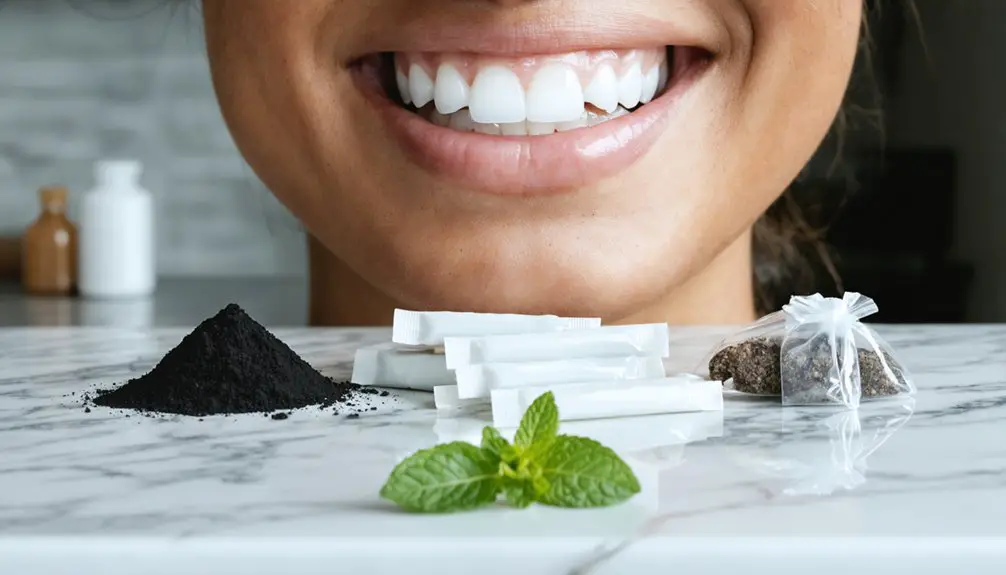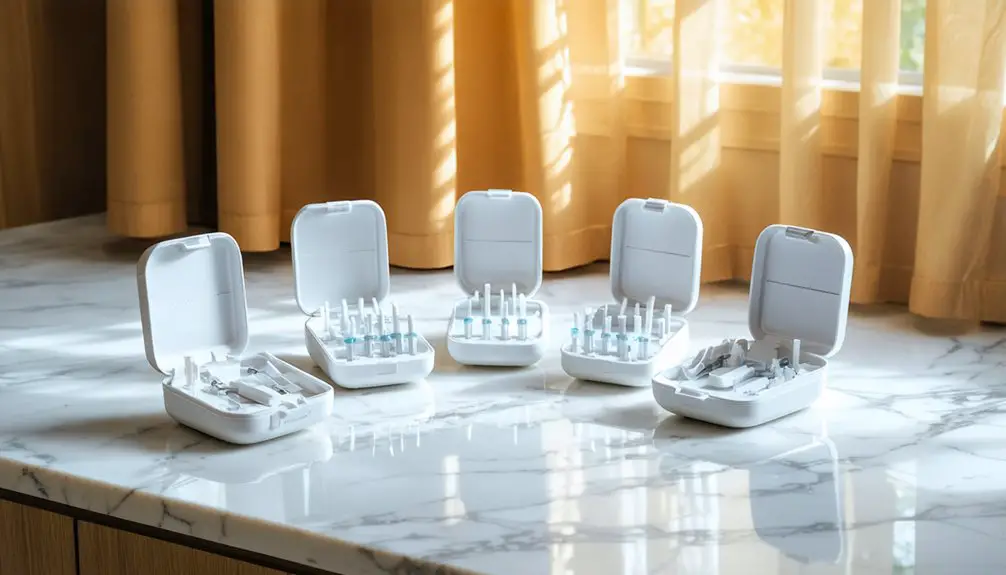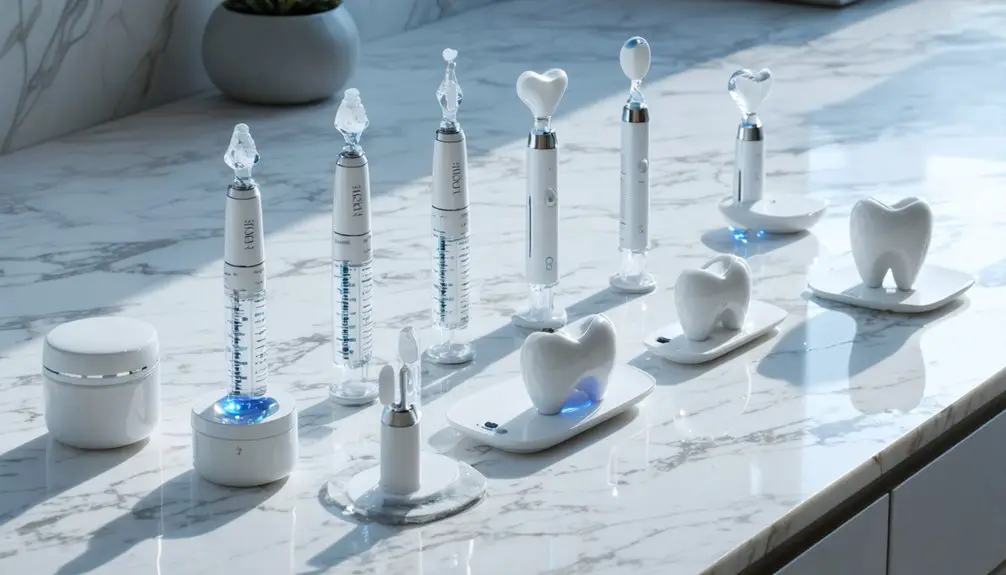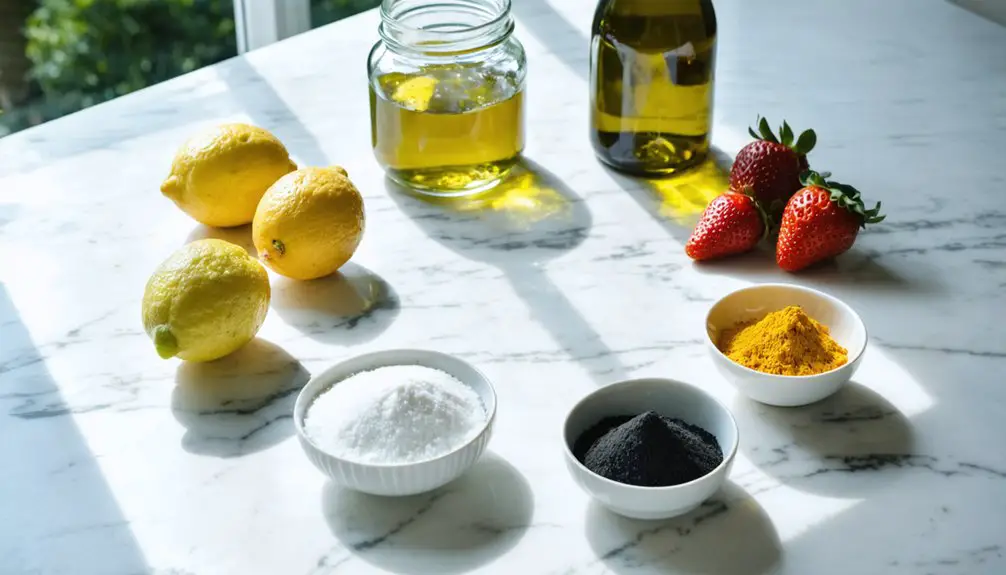You’ll find natural teeth whitening kits offer a gentle yet effective way to brighten your smile using ingredients like baking soda, activated charcoal, and fruit acids. These alternatives can lighten teeth up to four shades within 3-6 weeks, though results take longer than commercial options. While professional treatments deliver immediate changes, natural solutions protect your enamel integrity and minimize sensitivity. Understanding the science and application techniques will maximize your whitening success.
Key Takeaways
- Baking soda combined with hydrogen peroxide creates a safe, effective natural whitening paste that gradually removes surface stains.
- Natural whitening treatments typically show visible results within 3-6 weeks when used consistently and properly.
- Activated charcoal’s adsorption properties naturally lift stains from teeth, though gentle application is crucial to protect enamel.
- Natural solutions cost significantly less than professional treatments while being safer for long-term enamel health.
- Fruit acids and coconut oil provide gentle whitening effects while helping reduce harmful bacteria in the mouth.
Understanding Natural Whitening Ingredients
While many commercial teeth whitening products rely on harsh chemicals, natural ingredients can provide effective whitening results with potentially fewer side effects. Understanding the science behind these ingredients helps you make informed choices for your natural whitening journey.
Baking soda benefits include its mild abrasive properties that effectively remove surface stains while protecting enamel integrity. When combined with hydrogen peroxide, it creates a powerful yet gentle whitening paste. Special occasions and confidence often motivate people to seek natural whitening solutions. Results may vary since natural tooth color affects the final whiteness achieved.
Activated charcoal efficacy stems from its ability to adsorb stains through surface contact, though its higher abrasiveness requires careful application. Other natural options include strawberries containing malic acid for gentle exfoliation, and coconut oil for bacterial reduction.
While fruit acids can whiten teeth, they should be used cautiously to prevent enamel erosion. Each ingredient offers unique advantages when properly incorporated into your oral care routine.
Popular Over-the-Counter Options
Over-the-counter teeth whitening kits offer varying levels of effectiveness through different delivery methods, from strips to trays to LED-enhanced systems.
You’ll find options ranging from affordable to premium, with varying time commitments and results.
Here’s what you need to know about leading OTC whitening solutions:
- Crest Whitestrips Professional Express delivers 2.6 shade improvements within 19 days, enhanced by an LED light device for maximum effectiveness. For optimal stain removal results, users reported 100% satisfaction ratings with no gum irritation. Professional consultation is recommended since peroxide concentration determines both safety and results.
- Plus White’s 5 Minute Kit provides an economical option at $11.49, featuring moldable trays for better coverage.
- Strip systems offer convenient, mess-free application with direct peroxide contact on tooth surfaces.
- Tray-based systems allow for stronger bleaching concentrations and improved contact time, though proper fitting is essential.
Choose based on your budget, time availability, and sensitivity concerns to achieve peak whitening results.
The Science Behind Teeth Whitening
When you use teeth whitening products, hydrogen peroxide or carbamide peroxide penetrates your tooth enamel and releases free radicals that break down complex stain molecules.
These reactive oxygen species target both surface stains and deeper discoloration within the dentin layer through a multidirectional diffusion process.
Your whitening gel’s effectiveness depends on the peroxide concentration and activation method, with light or laser activation accelerating the breakdown of stains through enhanced free radical production.
The whitening gel typically reaches the inner tooth structure in 5 to 15 minutes after application.
Regular dental cleanings and consistent good oral hygiene can help maintain your whitening results by preventing new surface stains from developing.
Understanding Whitening Chemical Reactions
The science behind teeth whitening revolves around powerful oxidizing agents that break down stain-causing molecules through chemical reactions. When you apply whitening agents like hydrogen peroxide or carbamide peroxide to your teeth, they trigger a complex series of chemical reactions that penetrate your enamel and dentin.
Here’s how the whitening process works:
- The whitening agents release reactive oxygen species (free radicals) that target pigmented molecules.
- These free radicals break down double bonds in chromogenic compounds, making them colorless.
- The oxidation process continues for up to two weeks as oxygen remains trapped in tooth structure.
- Light activation can accelerate the reaction by catalyzing peroxide decomposition.
The effectiveness of these chemical reactions depends on factors like concentration, pH levels, and contact time with your teeth’s surface. Professional treatments utilizing high-concentration gels deliver faster results than home whitening methods. Carbamide peroxide formulations offer a more stable shelf life compared to hydrogen peroxide, making them ideal for take-home treatments.
Stain Removal Mechanisms Explained
Modern teeth whitening products rely on multiple mechanisms working in concert to eliminate stains and restore natural tooth brightness. When you use these products, abrasive techniques physically scrub away surface stains through ingredients like hydrated silica, while enzymatic action breaks down protein-based discolorations at the molecular level. The most effective professional treatments utilize hydrogen peroxide agents for rapid stain oxidation. The whitening process occurs as oxygen molecules penetrate through the enamel and dentin layers.
Surfactants enhance the effectiveness by loosening stubborn stains and improving contact between whitening agents and your teeth’s surface.
To prevent future staining, antiredeposition agents create a protective barrier that blocks new chromophores from attaching. Additionally, calcium phosphate compounds, particularly hydroxyapatite, form a white protective layer that both masks existing discoloration and strengthens your enamel.
This multi-faceted approach guarantees thorough stain removal while protecting your teeth’s natural structure.
Safe Usage Guidelines and Best Practices
You’ll find ideal results by strictly following your whitening kit’s application instructions, including recommended duration and frequency of use to protect your enamel.
When applying whitening products, you should limit each session to 30-60 minutes and maintain a consistent schedule over the prescribed 10-14 day treatment period.
If you experience tooth sensitivity, you can reduce application time or temporarily pause treatment while using desensitizing toothpaste to manage discomfort.
Proper Application Methods
Successfully whitening teeth at home requires careful attention to proper application methods and safety protocols.
Mastering proper application techniques and gel safety will help you achieve the best results while protecting your oral health.
Follow these essential steps for safe and effective whitening:
- Apply a small drop of gel to the front inner surface of each tooth impression in your tray, avoiding excess that could contact your gums.
- Insert the tray quickly and firmly, then immediately wipe away any gel that seeps onto your gums using a clean finger or tissue.
- Verify your whitening trays are properly trimmed to contact only your teeth, allowing comfortable mouth closure.
- Clean your trays thoroughly after each use with cold water and store them in a cool, dry place to maintain their integrity.
Duration and Frequency Tips
Beyond proper application techniques, understanding the right duration and frequency of teeth whitening treatments plays an essential role in achieving excellent results safely.
For LED-activated natural kits, limit your whitening duration to 10-20 minutes per session, while peroxide-based products typically require 20-30 minutes. Don’t exceed one hour of exposure, regardless of the product type.
For treatment frequency, stick to once-daily applications and complete a 1-2 week cycle for optimal results. If you experience sensitivity, reduce frequency or take breaks between sessions.
Remember to clean your teeth thoroughly before each treatment and use minimal gel to prevent gum irritation. After completing your initial whitening cycle, maintain results with weekly or biweekly touch-ups while avoiding staining substances between treatments.
Preventing Tooth Sensitivity
While teeth whitening can deliver remarkable results, managing potential tooth sensitivity requires an all-encompassing approach that combines preventive measures and proper technique.
Effective sensitivity management starts with using desensitizing agents before, during, and after your whitening treatment.
- Begin using desensitizing toothpaste containing potassium nitrate and fluoride 10-14 days before your whitening treatment.
- Select whitening products with lower peroxide concentrations and use custom-fit trays to control gel exposure.
- Avoid hot, cold, or acidic foods during treatment, and drink through a straw to minimize contact with sensitive areas.
- Maintain gentle oral hygiene practices using a soft-bristled toothbrush and sensitivity-formulated toothpaste for at least 48 hours post-treatment.
Comparing Natural vs. Commercial Solutions
Although both natural and commercial teeth whitening solutions aim to brighten smiles, they differ greatly in their approach, effectiveness, and safety profiles.
Natural efficacy tends to be milder, requiring longer treatment periods but offering gentler results with fewer side effects. In contrast, commercial strength treatments, especially professional options, can whiten teeth up to eight shades in a single session.
You’ll find natural solutions more budget-friendly, with prices markedly lower than professional treatments that can cost $300-$600.
While commercial options provide faster, more uniform results through custom-fitted trays and higher peroxide concentrations, they may cause tooth sensitivity and gum irritation.
Natural alternatives, though less potent, offer safer whitening without compromising enamel integrity.
Consider your priorities regarding cost, time, and sensitivity when choosing between these options.
Timeline and Expected Results
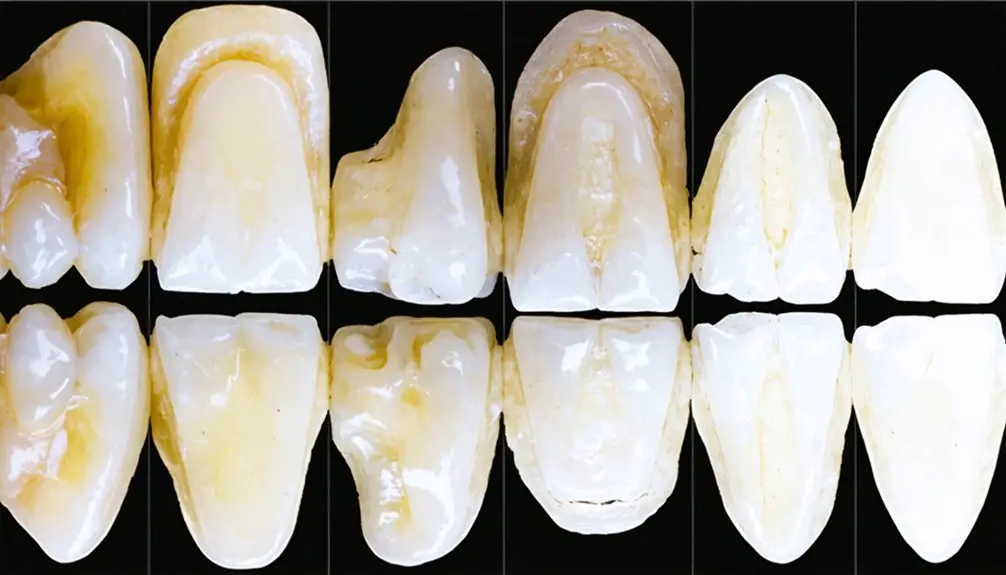
Understanding the timeline for teeth whitening helps set realistic expectations for your desired results. The treatment duration varies depending on your chosen method and the condition of your teeth, but most people achieve noticeable improvements within weeks of consistent use.
A realistic teeth whitening timeline gives you a clear path forward, helping you anticipate when you’ll see the smile you want.
You’ll typically experience whitening effectiveness in this progression:
- Initial subtle changes appear within the first few days of treatment.
- Visible brightening emerges between 7-14 days with professional or at-home kits.
- Maximum results develop by 2-3 weeks of regular application.
- Results can last 6 months to several years with proper maintenance.
Natural whitening kits generally require 3-6 weeks for significant results, while professional treatments offer immediate changes.
Your lifestyle habits and oral care routine will ultimately determine how long your brighter smile lasts.
Professional Tips for Long-Lasting Effects
To maximize the longevity of your teeth whitening results, implementing professional recommendations can make a significant difference in maintaining that bright smile.
Focus on establishing consistent maintenance routines, including regular dental checkups every six months and daily brushing with whitening toothpaste. The whitening frequency you’ll need depends on your lifestyle habits, but you can extend results by avoiding staining substances like coffee, tea, and red wine.
For peak effectiveness, use custom-fitted trays under professional supervision, as they guarantee precise application and reduce gum irritation.
Incorporate tooth-friendly foods into your diet, such as celery and apples, which promote natural cleansing. Remember to protect your gums during treatments and consider LED or laser-activated systems for enhanced, longer-lasting results.
Frequently Asked Questions
Can I Whiten My Teeth While Wearing Braces or Dental Implants?
You’ll get uneven results whitening with braces, risking patchy spots under brackets. For implant discoloration, whitening won’t affect artificial materials. Wait until your braces maintenance is complete for best results.
Will Whitening Treatments Affect the Color of Existing Dental Crowns?
No, whitening treatments won’t change your dental crowns’ color due to treatment compatibility issues. Your crowns’ non-porous materials resist bleaching agents, potentially causing discoloration mismatches with your natural teeth.
Is It Safe to Whiten Teeth While Pregnant or Nursing?
Like a cautious captain steering through foggy waters, you’ll want to postpone teeth whitening during pregnancy. Dental health experts recommend waiting until after pregnancy/nursing to avoid teeth sensitivity and potential risks.
How Do Medications Affect the Success of Teeth Whitening Treatments?
Your medications can greatly impact whitening effectiveness. Certain antibiotics like tetracycline cause resistant intrinsic stains, while antihistamines and antihypertensives reduce saliva production, making stain removal more challenging.
Can Teenagers Safely Use Natural Teeth Whitening Products?
You shouldn’t use whitening products until you’re at least 14-16 years old. For teen oral health and ideal whitening effectiveness, consult your dentist first and stick to gentle, dentist-approved options.
References
- https://pmc.ncbi.nlm.nih.gov/articles/PMC10024105/
- https://healthcare.utah.edu/the-scope/health-library/all/2023/10/does-home-teeth-whitening-really-work
- https://www.alpinewhite.com/en/article/teeth-whitening-statistics/
- https://www.bu.edu/articles/2012/the-truth-about-teeth-whiteners/
- https://www.frontiersin.org/journals/dental-medicine/articles/10.3389/fdmed.2021.687507/full
- https://www.rowlettdental.com/natural-teeth-whitening-remedies-do-they-really-work/
- https://pmc.ncbi.nlm.nih.gov/articles/PMC4058574/
- https://www.trysnow.com/blogs/news/teeth-whitening-ingredients
- https://www.goodhousekeeping.com/health-products/g28723133/best-at-home-teeth-whitening-products/
- https://nhdentistrybeverlyhills.com/press/6-of-the-best-teeth-whitening-kits-in-the-drugstore/
